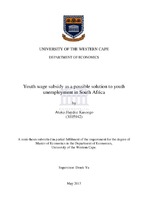Youth wage subsidy as a possible solution to youth unemployment in South Africa
Abstract
South Africa is characterised by its high and persistent level of unemployment, in particular
among the youth. The high youth unemployment is attributed to various reasons, ranging
from their lack of work experience, skills mismatch to employment and wage rigidities. The
South African government proposed the youth wage subsidy to be implemented in 2011, with
the primary aim of solving the youth unemployment problem. This study starts by providing a
literature review on the youth labour market trends since the transition; it emerged that there
is a lack of studies focusing exclusively on how youths fare in the labour market. Next, the
demographic and educational attainment characteristics of the youth narrow labour force,
employed and narrow unemployed are analysed under the narrow or strict definition, using
the 1995-1999 October Household Surveys (OHSs), the 2000-2007 Labour Force Surveys
(LFSs) and the 2008-2011 Quarterly Labour Force Surveys (QLFSs). With regard to
unemployed youths, it is found that they are more likely to be blacks, without Matric and have
never worked before. The main causes of youth unemployment are then discussed in detail,
before the thesis moves on to examine the various active and passive labour market policies
that could help to address the youth unemployment problem. The possible pros and cons of
the youth wage subsidy, one of the active policies and the focus of this study, are discussed in
greater detail. In particular, the claim by institutions such as COSATU that the introduction of
the subsidy would lead to elderly workers (who are not subsidised) being replaced by the
youth workers (who are subsidised) is not entirely correct, as these two groups of workers
could be complementary instead of substitutes, and the introduction of the subsidy
programme could result in an increase of demand for both elderly and youth workers. It is
concluded that, although the youth wage subsidy could be one of the feasible solutions to
stimulate demand for youth labour, it is not sufficient to address youth unemployment. It
needs to be complemented by the other policies, such as a job search subsidy (targeting
discouraged work seekers) and public employment programmes (e.g. Expanded Public Works
Programme); but it is most important to note that these policies could only be fully effective if
the root causes of youth unemployment are addressed by the government.

